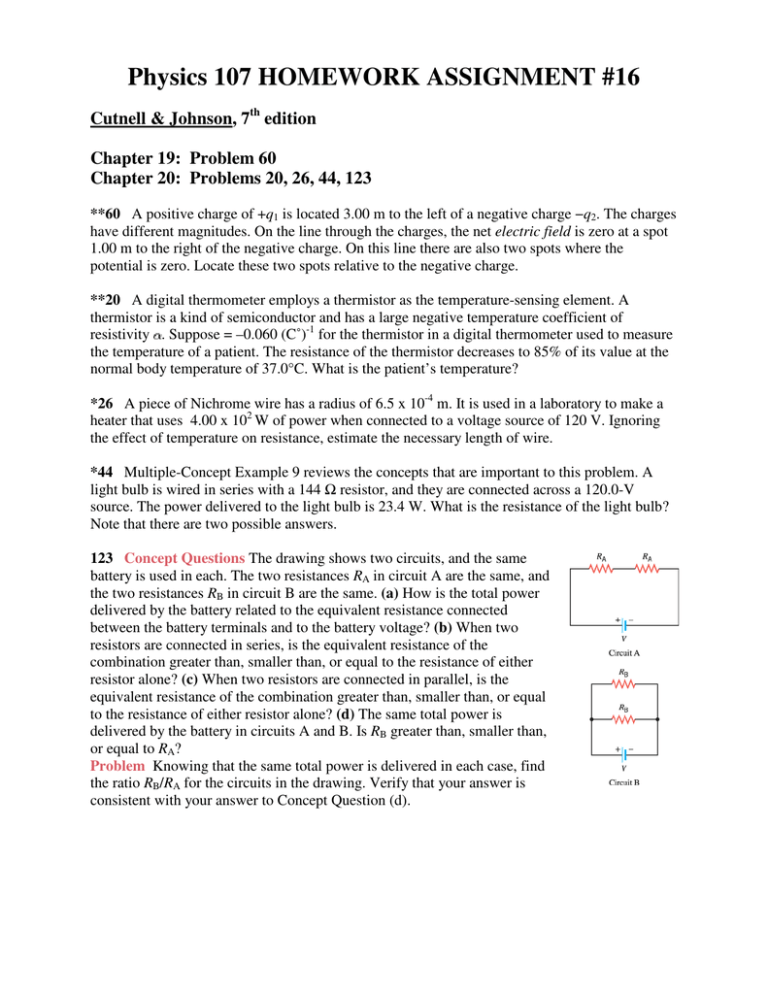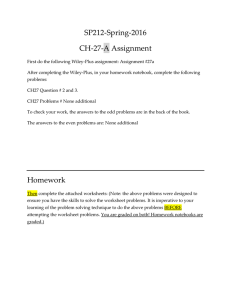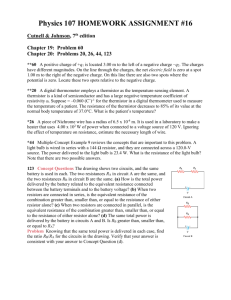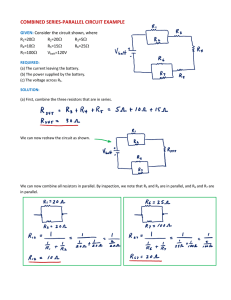Physics 107 HOMEWORK ASSIGNMENT #16
advertisement

Physics 107 HOMEWORK ASSIGNMENT #16 Cutnell & Johnson, 7th edition Chapter 19: Problem 60 Chapter 20: Problems 20, 26, 44, 123 **60 A positive charge of +q1 is located 3.00 m to the left of a negative charge −q2. The charges have different magnitudes. On the line through the charges, the net electric field is zero at a spot 1.00 m to the right of the negative charge. On this line there are also two spots where the potential is zero. Locate these two spots relative to the negative charge. **20 A digital thermometer employs a thermistor as the temperature-sensing element. A thermistor is a kind of semiconductor and has a large negative temperature coefficient of resistivity . Suppose = –0.060 (C˚)-1 for the thermistor in a digital thermometer used to measure the temperature of a patient. The resistance of the thermistor decreases to 85% of its value at the normal body temperature of 37.0°C. What is the patient’s temperature? *26 A piece of Nichrome wire has a radius of 6.5 x 10-4 m. It is used in a laboratory to make a heater that uses 4.00 x 102 W of power when connected to a voltage source of 120 V. Ignoring the effect of temperature on resistance, estimate the necessary length of wire. *44 Multiple-Concept Example 9 reviews the concepts that are important to this problem. A light bulb is wired in series with a 144 Ω resistor, and they are connected across a 120.0-V source. The power delivered to the light bulb is 23.4 W. What is the resistance of the light bulb? Note that there are two possible answers. 123 Concept Questions The drawing shows two circuits, and the same battery is used in each. The two resistances RA in circuit A are the same, and the two resistances RB in circuit B are the same. (a) How is the total power delivered by the battery related to the equivalent resistance connected between the battery terminals and to the battery voltage? (b) When two resistors are connected in series, is the equivalent resistance of the combination greater than, smaller than, or equal to the resistance of either resistor alone? (c) When two resistors are connected in parallel, is the equivalent resistance of the combination greater than, smaller than, or equal to the resistance of either resistor alone? (d) The same total power is delivered by the battery in circuits A and B. Is RB greater than, smaller than, or equal to RA? Problem Knowing that the same total power is delivered in each case, find the ratio RB/RA for the circuits in the drawing. Verify that your answer is consistent with your answer to Concept Question (d). 60. REASONING AND SOLUTION The information about the electric field requires that 2 2 k q2 /(1.00 m) = k q1 /(4.00 m) so q2 = (1/16.0) q1 Since q2 is negative and q1 is positive, this result implies that − q2 = q1 /16.0 (1) Let x be the distance of the zero-potential point from the negative charge and d be the separation between the charges. Then, the total potential is kq1/(d + x) + kq2/x = 0 if the point is to the right of q2 and kq1/(d − x) + kq2/x = 0 if the point is between the charges and to the left of q2. Using Equation (1) and solving for x in each case gives x = 0.200 m to the right of the negative charge x = 0.176 m to the left of the negative charge 20. REASONING AND SOLUTION The resistance of the thermistor decreases by 15% relative to its normal value of 37.0 °C. That is, ∆R R − R0 = = −0.15 R0 R0 According to Equation 20.5, we have R = R0[1 + α (T – T0)] (R – R0) = α R0(T – T0) or R − R0 or R0 = α (T − T0 ) = −0.15 Rearranging this result gives T = T0 + −0.15 α = 37.0 °C + −0.15 −0.060 ( C° ) −1 = 39.5 °C 26. REASONING AND SOLUTION We know that the resistance of the wire can be obtained from 2 2 P = V /R or R = V /P 2 We also know that R = ρL/A. Solving for the length, noting that A = π r , and using ρ = 100 × 10–8 Ω.m from Table 20.1, we find L= RA ρ V 2 / P )(π r 2 ) V 2π r 2 ( = = = ρ ρP (120 V )2 π ( 6.5 × 10 –4 m ) ( )( 2 100 × 10 –8 Ω ⋅ m 4.00 × 102 W ) = 50 m 44. REASONING The circuit containing the light bulb and resistor is shown in the drawing. 2 The resistance R of the light bulb is related to the power delivered to it by R1 = P1 / I 1 (Equation 20.6b), where I is the current in the circuit. The power is known, and the current can be obtained from Ohm’s law as the voltage V of the source divided by the equivalent resistance R of the series circuit: I = V / RS . Since the two resistors are wired in series, the S equivalent resistance is the sum of the resistances, or RS = R1 + R2 . Light bulb R2 = 144 Ω R1 P1 = 23.4 W 120.0 V SOLUTION The resistance of the light bulb is R1 = P1 (20.6b) I2 Substituting I = V / RS (Equation 20.2) into Equation 20.6b gives R1 = P1 I2 = P1 (V / RS ) 2 = P1 RS2 V2 (1) The equivalent resistance of the two resistors wired in series is RS = R1 + R2 (Equation 20.16). Substituting this expression for RS into Equation (1) yields R1 = P1 RS2 V2 = P1 ( R1 + R2 ) 2 V2 Algebraically rearranging this equation, we find that V2 2 R12 + 2 R2 − R1 + R2 = 0 P1 This is a quadratic equation in the variable R1. The solution can be found by using the quadratic formula (see Appendix C.4): R1 = = V2 − 2 R2 − ± P1 (120.0 V )2 − 2 (144 Ω ) − ± 23.4 W = 85.9 Ω and 2 V2 2 2 R2 − − 4 R2 P1 2 2 (120.0 V )2 2 2 (144 Ω ) − − 4 (144 Ω ) 23.4 W 2 242 Ω 123. CONCEPT QUESTIONS a. The total power P delivered by the battery is related to the equivalent resistance Req connected between the battery terminals and to the battery voltage V according to 2 Equation 20.6c: P = V / Req . b. When two resistors are connected in series, the equivalent resistance RS of the combination is greater than the resistance of either resistor alone. This can be seen directly from RS = R1 + R2 (Equation 20.16). c. When two resistors are connected in parallel, the equivalent resistance RP of the combination is smaller than the resistance of either resistor alone. This can be seen directly −1 −1 −1 by substituting values in RP = R1 + R2 (Equation 20.17) or by reviewing the discussion in Section 20.7 concerning the water flow analogy for electric current in a circuit. d. Since the total power delivered by the 2 battery is P = V / Req and since the power and the battery voltage are the same in both cases, it follows that the equivalent resistances are also the same. But the parallel combination has an equivalent resistance RP that is smaller than RB, whereas the series combination has an equivalent resistance RS that is greater than RA. This means that RB must be greater than RA, as Diagram 1 at the right shows. If RA were greater than RB, as in Diagram 2, the equivalent resistances RS and RP would not be equal. Resistance Resistance RS Diagram 1 RB RA RS = RP RB RA RP Diagram 2 SOLUTION As discussed in our answer to Concept Question (d), the equivalent resistances in circuits A and B are equal. According to Equations 20.16 and 20.17, the series and parallel equivalent resistances are RS = RA + RA = 2 RA 1 1 1 = + RP RB RB or RP = 12 RB Setting the equivalent resistances equal gives 2 RA = 12 RB As expected, RB is greater than RA. or RB RA = 4






